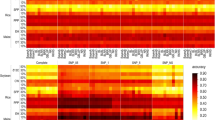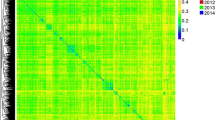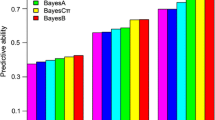Abstract
In comparison to conventional marker-assisted selection (MAS), which utilizes only a subset of genetic markers associated with a trait to predict breeding values (BVs), genome-wide selection (GWS) improves prediction accuracies by incorporating all markers into a model simultaneously. This strategy avoids risks of missing quantitative trait loci (QTL) with small effects. Here, we evaluated the accuracy of prediction for three corn flowering traits days to silking, days to anthesis, and anthesis-silking interval with GWS based on cross-validation experiments using a large data set of 25 nested association mapping populations in maize (Zea mays). We found that GWS via ridge regression-best linear unbiased prediction (RR-BLUP) gave significantly higher predictions compared to MAS utilizing composite interval mapping (CIM). The CIM method may be selected over multiple linear regression to decrease over-estimations of the efficiency of GWS over a MAS strategy. The RR-BLUP method was the preferred method for estimating marker effects in GWS with prediction accuracies comparable to or greater than BayesA and BayesB. The accuracy with RR-BLUP increased with training sample proportion, marker density, and heritability until it reached a plateau. In general, gains in accuracy with RR-BLUP over CIM increased with decreases of these factors. Compared to training sample proportion, the accuracy of prediction with RR-BLUP was relatively insensitive to marker density.








Similar content being viewed by others
Abbreviations
- ASI:
-
Anthesis silking interval
- BV:
-
Breeding value
- CIM:
-
Composition interval mapping
- DA:
-
Day till anthesis
- DS:
-
Days till silking
- GWS:
-
Genome-wide selection
- ICE:
-
Iterative conditional expectation
- LOD:
-
Logarithm of odds
- MAS:
-
Marker-assisted selection
- MLR:
-
Multiple linear regression
- MCMC:
-
Monte Carlo Markov chain
- NAM:
-
Nested association mapping
- QTL:
-
Quantitative trait loci
- RIL:
-
Recombinant inbred line
- RR-BLUP:
-
Ridge regression-best linear unbiased prediction
- SNP:
-
Single nucleotide polymorphisms
References
Beavis WD (1994) QTL analysis: power, precision and accuracy. In: Paterson AH (ed) Molecular dissection of complex traits. CRC Press, Boca Raton, pp 145–162
Bernardo R, Yu J (2007) Prospects for genomewide selection for quantitative traits in maize. Crop Sci 47:1082–1090
Buckler ES, Holland JB, Bradbury PJ, Acharya CB, Brown PJ, Browne C, Ersoz E, Flint-Garcia S, Garcia A, Glaubitz JC (2009) The genetic architecture of maize flowering time. Science 325:714–718
Habier D, Fernando RL, Dekkers JCM (2007) The impact of genetic relationship information on genome-assisted breeding values. Genetics 177:2389–2397
Haley C, Knott S (1992) A simple regression method for mapping quantitative trait loci in line crosses using flanking markers. Heredity 69:315–324
Hayes B, Bowman P, Chamberlain A, Goddard M (2009) Invited review: genomic selection in dairy cattle: progress and challenges. J Dairy Sci 92:433–443
Heffner EL, Sorrells ME, Jannink JL (2009) Genomic selection for crop improvement. Crop Sci 49:1–12
Henderson CR (1984) Applications of linear models in animal breeding. University of Guelph, ON
Jannink JL, Lorenz AJ, Iwata H (2010) Genomic selection in plant breeding: from theory to practice. Brief Funct Genomics 9:166–177
Jansen RC (1993) Interval mapping of multiple quantitative trait loci. Genetics 135:205–211
Lande R, Thompson R (1990) Efficiency of marker-assisted selection in the improvement of quantitative traits. Genetics 124:743–756
Lee SH, van der Werf JHJ, Hayes BJ, Goddard ME, Visscher PM (2008) Predicting unobserved phenotypes for complex traits from whole-geome SNP data. PloS Genet 4:e1000231. doi:10.1371/journal.pgen.1000231
Legarra A, Robert-Granie C, Manfredi E, Elsen JM (2008) Performance of genomic selection in mice. Genetics 180:611–618
Lorenzana RE, Bernardo R (2009) Accuracy of genotypic value predictions for marker-based selection in biparental plant populations. Theor Appl Genet 120:151–161
Meuwissen TH, Hayes BJ, Goddard ME (2001) Prediction of total genetic value using genome-wide dense marker maps. Genetics 157:1819–1829
Meuwissen TH, Goddard ME (2010) Accurate prediction of genetic values for complex traits by whole genome resequencing. Genetics 185:623–631
Meuwiseen TH, Solberg TR, Shepherd R, Woolliams JA (2009) A fast algorithm for BayesB type of prediction of genome-wide estimates of genetic value. Genet Sel Evol 41(1):2
Piyasatian N, Fernando R, Dekkers JCM (2007) Genomic selection for marker-assisted improvement in line crosses. Theor Appl Genet 115:665–674
Utz HF, Melchinger AE, Schön CC (2000) Bias and sampling error of the estimated proportion of genotypic variance explained by quantitative trait loci determined from experimental data in maize using cross validation and validation with independent samples. Genetics 154:1839–1849
Xu S (2003) Estimating polygenic effects using markers of the entire genome. Genetics 163:789–801
Xu S (2007) An empirical Bayes method for estimating epistatic effects of quantitative trait loci. Biometrics 63:513–521
Zeng ZB (1994) Precision mapping of quantitative trait loci. Genetics 136:1457–1468
Zeng ZB (1993) Theoretical basis for separation of multiple linked gene effects in mapping quantitative trait loci. Proc Natl Acad Sci 90:10972–10976
Acknowledgments
The authors of the current manuscript would like to thank researchers and institutions who contributed to the Panzea database (http://www.panzea.org/). In addition, the authors would like express gratitude to the two anonymous reviewers for their detailed input in assessment of the manuscript.
Author information
Authors and Affiliations
Corresponding author
Additional information
Communicated by M. Sillanpaa.
Rights and permissions
About this article
Cite this article
Guo, Z., Tucker, D.M., Lu, J. et al. Evaluation of genome-wide selection efficiency in maize nested association mapping populations. Theor Appl Genet 124, 261–275 (2012). https://doi.org/10.1007/s00122-011-1702-9
Received:
Accepted:
Published:
Issue Date:
DOI: https://doi.org/10.1007/s00122-011-1702-9




